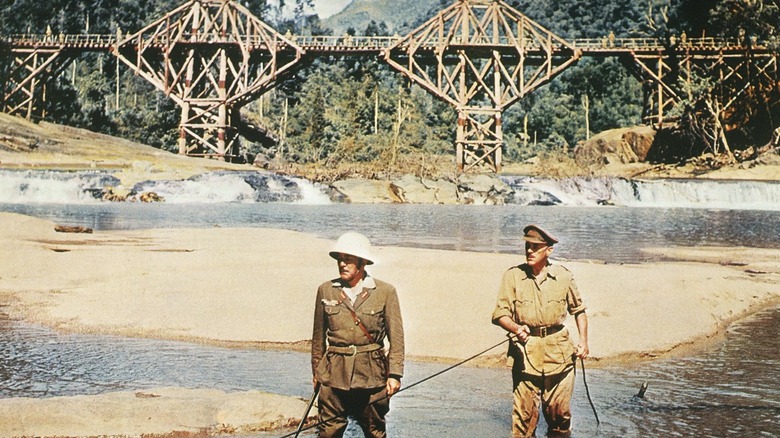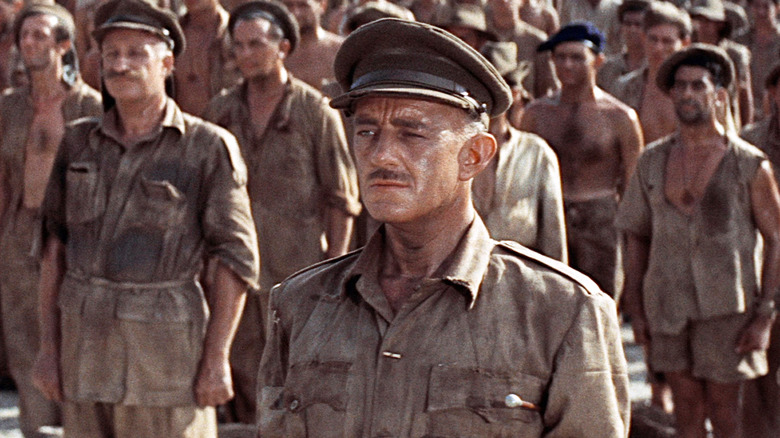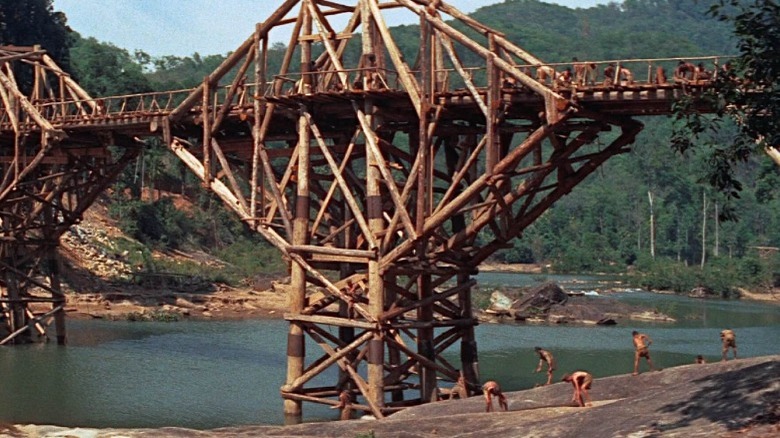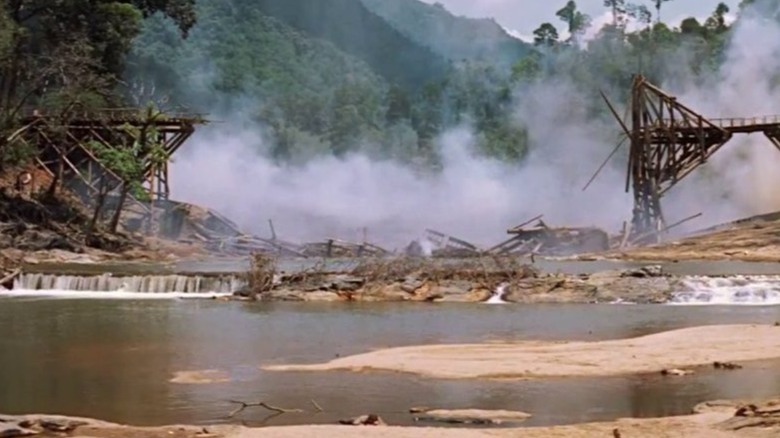The Bridge On The River Kwai's Bridge Went Through An Incredible Construction Process
The road to developing "The Bridge on the River Kwai" into a feature film was long. Producer Sam Spiegel, a classic movie mogul for all it entails (flashes of creative brilliance, dictatorial tendencies, and a creepy fixation on teenage girls), saw in Pierre Boulle's 1952 novel the chance to make a truly stirring wartime epic. The book was a highly fictitious retelling of the disastrous building of the Burma Railway by Japan's prisoners of war that softened the real tragedy of the Burma Railway, and maybe a movie would soften it further. But Spiegel had the sensibilities and know-how of a Hollywood showman, and he saw to it the film was released in the fall of 1957 to much acclaim.
The movie, directed by the magisterial British filmmaker David Lean, opens with a long prison march, as British soldiers, plus a lone American, protagonist Shears (William Holden), are dragged into an inhumane prison camp by the Japanese army. There, they will build a bridge, one of great strategic value to the Japanese in the Burmese theater of World War II. The British Colonel Nicholson (Alec Guinness) objects at first but over time takes the construction over. His moral compass decays and he begins to see the bridge as a symbol of British superiority. Meanwhile, Shears escapes and is enlisted to blow the bridge up.
To build the bridge for a film production required commitment and ingenuity, especially since they wouldn't be using miniatures, and would be building on-location. They would also need to blow it up.
No miniatures for this epic
When Sam Spiegel spoke with director Howard Hawks about making "Bridge on the River Kwai," the veteran filmmaker's interest quickly waned, according to Natasha Fraser-Cavassoni's "Sam Spiegel" biography. Spiegel wanted a big-budget epic and an American lead, but Hawks, as others would, felt the story was ultimately more marginal and in need of a "limited budget." It took David Lean, then working on the set of the lush 1955 Katharine Hepburn romance "Summertime," for Spiegel to find someone who could see what he saw. Lean's early British films would ultimately inspire Sofia Coppola, but the epics he would make with Spiegel would be his legacy.
Per Fraser-Cavassoni, Spiegel's vulgarity and complexities led to immediate tension between him and Lean, a brilliant but paranoid artist who never met a producer he could trust. But the producer was also a necessary instrument for the actual completion of "Bridge on the River Kwai," in part because he took the financial aspect of the movie seriously. His long quest for a director was just one part of that, and if the two had difficulties, they also strove to make the best possible movie. As Lean's biographer Kevin Brownlow said:
"The film could have been made in six days in an English studio like Merton Park using miniatures. It would have come and gone and everyone would have said 'he did the best he could,' but Lean resisted that sort of film."
Building bridges
To play the location of Thailand, where the Burma Railway was actually constructed, Sam Spiegel and production designer Don Ashton decided to film in the Colombo region of Ceylon (now Sri Lanka). With its visible heat and rich jungles, it made for a fairly different location from Yugoslavia, Spiegel's original choice according to Natasha Fraser-Cavassoni's "Sam Spiegel." The bridge would be built in Kitulgala, a small river town not far from Colombo.
The bridge was already built in January of 1957, while the movie was still undergoing casting and Columbia Pictures was threatening to shut production down. As Don Ashton told an anxious Spiegel, "you'll be the only one with a bridge to sell." Luckily, production resumed – if not smoothly or on schedule.
To erect the bridge, a grand and iconic cinematic fixture, Spiegel claimed to have spent over a quarter of a million dollars, and eight months, according to the New York Times. However, Ashton claimed some of these figures were a little inflated by Spiegel, who wanted to convince moviegoers of the movie's magnitude. He would tell Fraser-Cavassoni that the price was closer to $50,000 and that local labor, as well as the river's local elephants, had helped the effort tremendously. Somehow, Spiegel, the same man who nearly forced Peter O'Toole out of "Lawrence of Arabia," split the difference between the route of cheap miniatures and the route of epic location work.
Now, they would need explosives for the movie's climax, wherein Frears returns to the camp and destroys the bridge.
Blowing it up
While Pierre Boulle's novel (as well as the actual history) saw the efforts by Allied forces to destroy the bridge fail, the film version of "The Bridge on the River Kwai" was a massive Hollywood production, not a satirical French novel. The bridge would burn.
After all that effort in constructing the bridge, and all the alleged money it cost, David Lean and Sam Spiegel would need explosives. The movie sees the explosion from multiple different angles, all of which had to be rolling concurrently to capture the bridge (in CinemaScope) blowing up, as well as the collapse of the approaching train. To commemorate the filming, Spiegel (according to Natasha Fraser-Cavassoni's biography) invited numerous local celebrities like Ceylon's Prime Minister, Solomon Bandaranaike, out to watch it. They came for nothing, as the train simply rolled on along the bridge. Lean had canceled the explosion.
Per Fraser-Cavassoni, Lean had arranged for five different cameramen to record the explosion, and he set up an electronic panel with lights denoting which cameras were on. As the train began to roll, the lights turned on. Except for one. Forced to make a tough call, unaware of the safety of this cameraman, Lean called off the whole thing and it was rescheduled for the next day. Freddy Ford, the camera operator, had simply forgotten to start rolling.
While they didn't exactly get along and suffered together through a difficult production, Spiegel and Lean would do the same just three years later for 1960s "Lawrence of Arabia." For all their difficulties there, at least there were no bridges.



